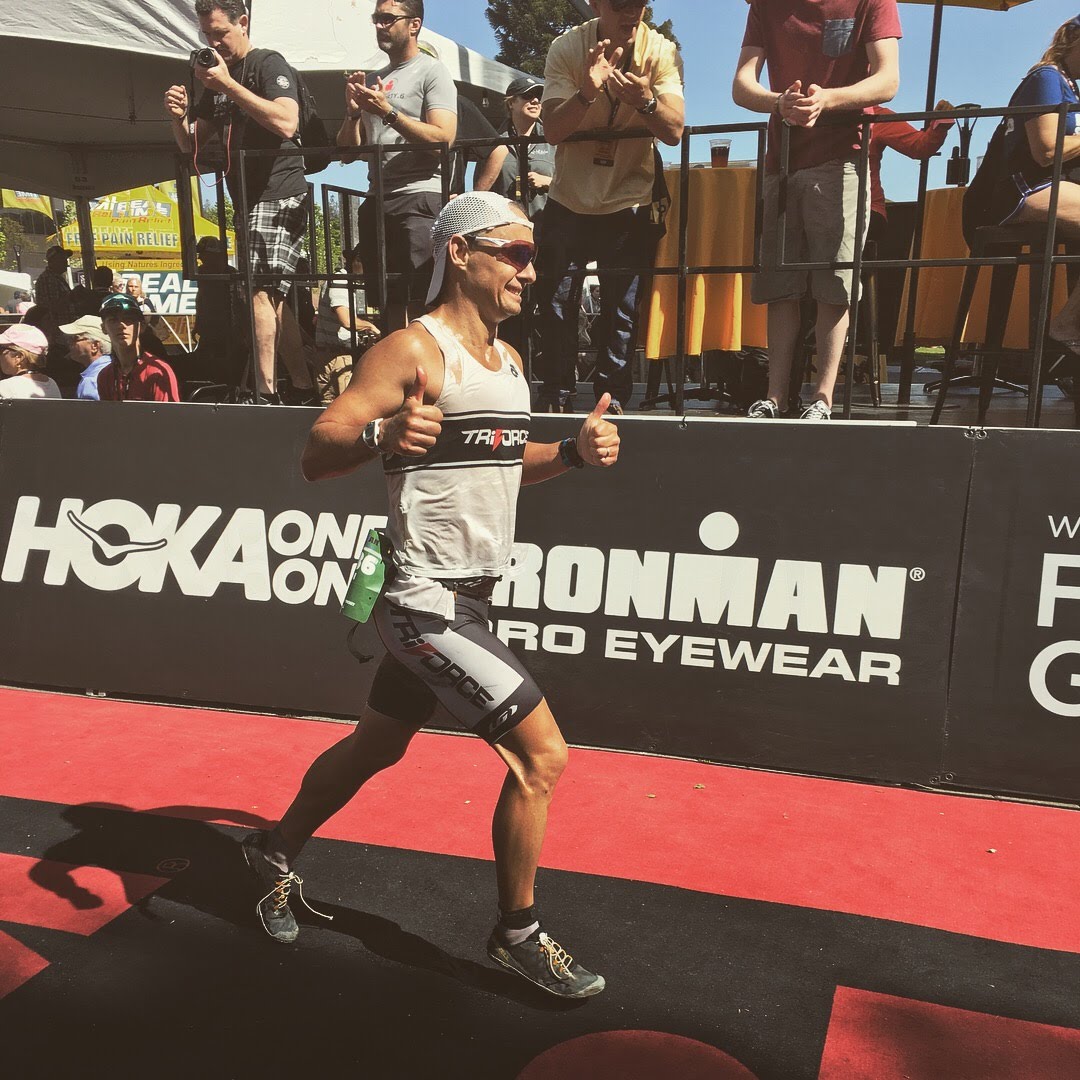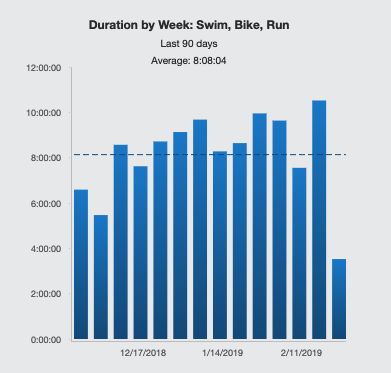I’m halfway through my 10 hours per week Ironman Training experiment! The goal is to qualify for Kona on a minimalist training plan. I’ll stick to 10 hours per week of training until 6 weeks out from the taper. Once I hit that point I’ll see where I’m at how much “extra” I want to add in order to be ready to go the distance. So far, I’m loving the plan and it’s working (surprisingly) well, especially the bike training. The only area of concern is my run durability / endurance (and injuries). If you are a busy athlete I hope you’ll get some useful information in this update to try in your own training plan.
(UPDATE: Spoiler alert: IT WORKED!!!!! I won my age group with a time of 9:26 and qualified for Kona!)
First off, I’m LOVING this training.
Before I get into the numbers and get all goal oriented (as we triathletes tend to do), let me say how much I’m enjoying the training.
- The thing I love most about this plan is only training once per day (especially since it is February!). It makes life so much simpler.
- The once per day training and the reduced hours has made me much more productive. I have much more energy for work, family and friends.
- I also really enjoy the workouts. While some people love to go out and ride 100 miles at an endurance effort I’ve always preferred just to crank it for 2-3 hours at more of a race-like effort. And I love running fast off the bike, so the threshold brick run and the IM effort brick runs are a fun challenge. It might not be for everyone (we have a few TriForcers who love to go out and ride long every weekend), but it suits me.
That’s not to say that I don’t love “big training” sometimes. One of my favorite memories as a triathlete is when I did two 27 hour weeks in a row (of HARD) training with Brett Sutton and his pros back in 2016. I just like to keep training like that as an occasional “treat.” 🙂
The Hours
I’ve been averaging 8 hours / week over the last 90 days with most weeks between 8-10 hours and a biggest week of 10.5 hours.
There are 6 key areas I’m focusing on to be ready to qualify for Kona.
OK, here are the numbers we love so much. I’m guessing I need to go sub 9:30 which means swim around 1 hour, bike around 5 hours, run around 3:20. If my “IM effort” swim is around 1:25 / 100 yards, “IM effort” bike is around 210 watts, and “IM effort run” is around 7:30 then I should be there. By “IM effort” I mean power / pace at the perceived exertion and heart rate where I usually race Ironman. I still have to be fit enough / have the endurance / overall strength to do it, which is the hard part. In addition to my swim, bike and run I’m focusing on my weight, fixing my chronic injury issues, and also making sure my bike is set up well and reliable (last year I dropped my chain about 10x because of a wonky 1x setup).
I qualified for Kona last year on “regular” training– can I do it again on a minimal plan?
If I check these 6 boxes (and feel reasonably good on race day) I have an excellent chance of qualifying:
Here are my top updates / lessons half way through the plan (10 weeks left):
1. The Week Setup Works Surprisingly Well for Me.
My body is responding very well to the extra recovery in the program vs. a “regular” plan. Because of the 2 bricks in the plan, I have 3 “no legs” (swim only) days in the plan. The challenging brick days are pretty “race like” and fatiguing– having the swim days immediately afterwards is letting my body absorb the training. As a result I’m improving pretty steadily as opposed to when I try to “add extra” — which results in more frequent fatigue. My speed and power have been better with this setup vs. the last couple of years on a more traditional plan with higher volume. The only question is whether this setup will result in the overall strength, endurance and durability to “go the distance.” At this point I’d say the swim obviously will (it’s more or less regular swim training), the bike is already pretty darn close to ready to go the distance strong, BUT the run has a way to go (see #3)
An example week from a few weeks ago. The swim-only days (Tues, Thurs, Sat) have been allowing me to recover well from the hard bricks.
2. The Focused Indoor “Long” Rides Work
Limiting myself to a SOLID 3 hour indoor ride with a ton of time pegging it at around IM effort has been very effective. I used to do these sort of rides very frequently “back in the day” when my cycling was at lifetime bests. In theory these sorts of rides should be avoided as they can be considered extended “gray zone” efforts, but I’m doing them anyway and they flat out work. I’m much stronger than this time last year when I was doing longer outdoor endurance rides. I did my first 3 hour focused IM effort outdoor ride on the IMSR course a week ago and my NP at IM effort was 217 watts and I felt strong at the end and felt like I “should feel” at hour 3 of an IM bike. I’m so pleased with how these rides are going and how I’m performing that suspect I could do a great IM ride without ever going beyond 3 hours, but to be safe I’ll bump up the long rides in the last 6 weeks pre taper.
3. What’s Not Working– Run Durability.
My run speed is great (threshold is around 6 flat, “IM pace” around 7:15), but my durability (toughness in the legs to go the distance) is weak. This is magnified by the fact that my run injuries have forced me into barefoot shoes (a long story). But leaving the shoes aside, the 2 biggest things that build durability are (1) miles and (2) frequency, both of which are light in the plan. So, those will be 2 key things to address in “phase 3” — the last 6 weeks pre taper when I allow myself to add extra / go beyond 10 hours. But hopefully the injury rehab will come along quickly and I’ll be able to switch to more “regular” shoes which should be an instant increase in durability.
What’s Next?
We have 2 more weeks left until “phase 3” (6 weeks before 2 week taper). I’m just going to keep doing what I’m doing for the next 2 weeks, with a big focus on fixing my run injuries.
Once I hit phase 3, I don’t think I want to change too much other than the run training. Since the run speed is already there I’ll need to bump up the volume and frequency with some extra relatively slow running just to get the body toughened up.
Conclusion
The 10 hours per week Ironman training is working well so far and I’m having fun! If I can shore up my run endurance and durability in the final phase of training, I should be in a good position to qualify for Kona.
Thanks for reading!





